Samaaro + Your CRM: Zero Integration Fee for Annual Sign-Ups Until 30 June, 2025
- 00Days
- 00Hrs
- 00Min
In event organization, the first experience begins a day-long impression. There is no worse feeling than having guests stuck at the entry, primarily caused by distance or downtime due to poor or no Wi-Fi.
If you are managing a hotel ballroom-based conference, a summit in a remote convention centre, or a festival in an open field, the last thing you want is connectivity issues to affect guest management. This is where offline event check-in apps become indispensable to the function.
Offline event check-in apps allow you to transform registration from exercise of technical risk to a reliable and consistent activity. Everyone understands the basic premise: offline event check-in is the reliability event execution rests upon.
In the past, a system that either relied on traditional methods or was poorly designed caused enormous bottlenecks.

Modern-day event registration applications are developed with an “offline-first” approach, or a mindset that they need to work quite well without a network connection.
The main mechanism here is through local data cache. In advance of the event the entire guest list is securely downloaded to the check-in devices (on the fast devices – it is done overnight prior) in advance and the staff now utilizes the app to check guests in based on the QR code or name lookup. Any activity occurring is recorded locally and instantaneously with the activities recorded locally.
These apps are designed for quick entry without any touching, utilizing QR code scanning and tap-to-enter NFC, still working offline. The app simply checks the scanned code against the guest list that is stored locally. This is the fastest way to verify guests and is a core function of how offline check app technology facilitates a fast and uninterrupted flow of guests being checked-in, thus the lines are minimized even when doing this during peak capacities.
Once the device connects back to WiFi (even just for a quick minute) all the locally recorded guest check-in data can now Auto Sync all the recorded data back to the cloud and subsequently their party representation on the ground event inventory is updated. Also, for a larger event even if being used on ten devices as a guest check point all guest check-in inventories all syncs across devices so that all check-ins agree.
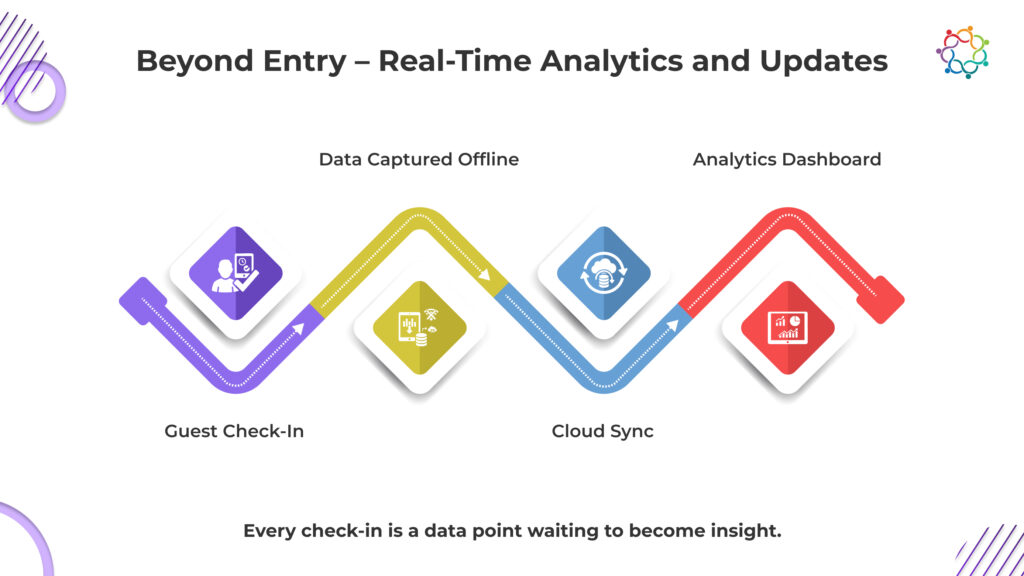
The benefits of offline event check-in solutions encompass more than just the point of entry; it will change your guest management quality level and post-event reports.
Data Capture Without Interruption
During the event, offline data will also contribute to the reporting and analytics, once you regain connection. This ensures an accurate and comprehensive attendance record, session attendance, and entrance time, regardless of unreliable connectivity at the venue.
Insights Worth Having
You will gain dashboards once the sync occurs, right after the data is synced. Check-in speed, attendance numbers, and segments are far easier to visualize just after the event for both reporting and ROI analysis.
For example, a great guest management tool will save staff’s time and efforts handling even categorizing, a 5,000-person summit reduced their wait by over 60% due to having an unsupported/insecure connection to the external network.
You can learn more about how streamlined check-in enhances the event experience here: https://samaaro.com/blogs/beyond-the-scan-how-samaaros-qr-codes-revolutionize-event-registration/
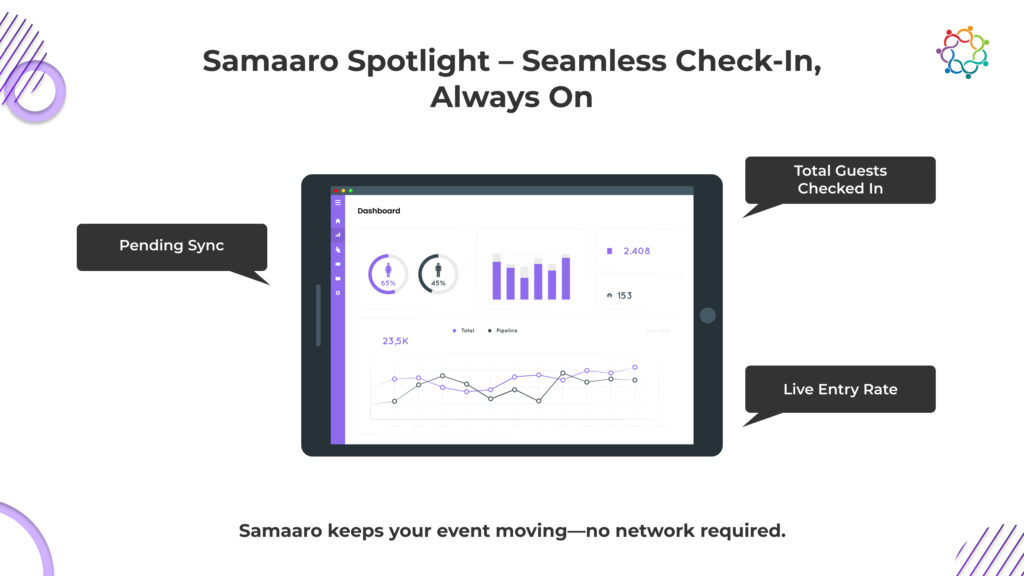
Samaaro understands that an enterprise event check-in application must be completely reliable. Our solution is developed to remove the number one source of onsite stress, a connectivity failure.
By 2026, your event’s success will be evaluated based on not only the quality of your content, but also on the seamless delivery of your logistics. The effectiveness of your events will be evaluated based on the seamless experience of your guests. When you use offline event check-in applications, you are making an investment in reliability, efficiency, and a better first impression for each and every participant.
The benefits of offline event registration are readily apparent, speed, accuracy, and peace of mind. Discover Samaaro’s offline event check-in applications for seamless event guest management
The United Arab Emirates has established itself as the Middle East’s number one global event destination, ranging from major global expos and trade shows to invitation-only C-level business events. Growth in this arena, expected to see the UAE event management market size grow to billions by 2030, is primarily bolstered by a critical evolution: businesses are “turning the corner” between traditional (one-off) events and tech-enabled, data-driven experiences.
At the forefront of this evolution is UAE event management software. For corporate innovators, this is much more than an optional tool for logistics; it is the power-source for measurable engagement and true business growth.
The UAE, especially Dubai and Abu Dhabi, leads the MICE (Meetings, Incentives, Conference and Exhibitions) market in the region. The initiatives of the government focusing on diversifying the economy from oil, the desire for world class tourism, and the legacy of the Expo 2020 have generated demand for more polished, seamless experiences for events as growing expectations and enhancements of experiences are concerning businesses today.
Companies and businesses started determining success not just on the attendance, but quality of leads, ROI on sponsorship, and engagement with the brand. Today’s competitive expectations have made incorporation of advanced event technology, also known as event management software UAE, a necessity for the region.

Investment in sophisticated event technology Middle East is driven by three primary commercial needs:
For a deeper understanding of the market dynamics shaping business strategy in this region, explore this comprehensive guide: Event Marketing & Sales in the UAE: A MENA Region Guide.

The appropriate event management software UAE will convert events away from cost centres into efficient sales and marketing engines.
Case in Point: One leading telco brand in the UAE took advantage of the all-in-one event platform to automate their annual B2B summit registration process, and check-in on-site. This resulted in a 40% reduction in administrative time for the event team, and a 25% improvement in lead follow-up speed.
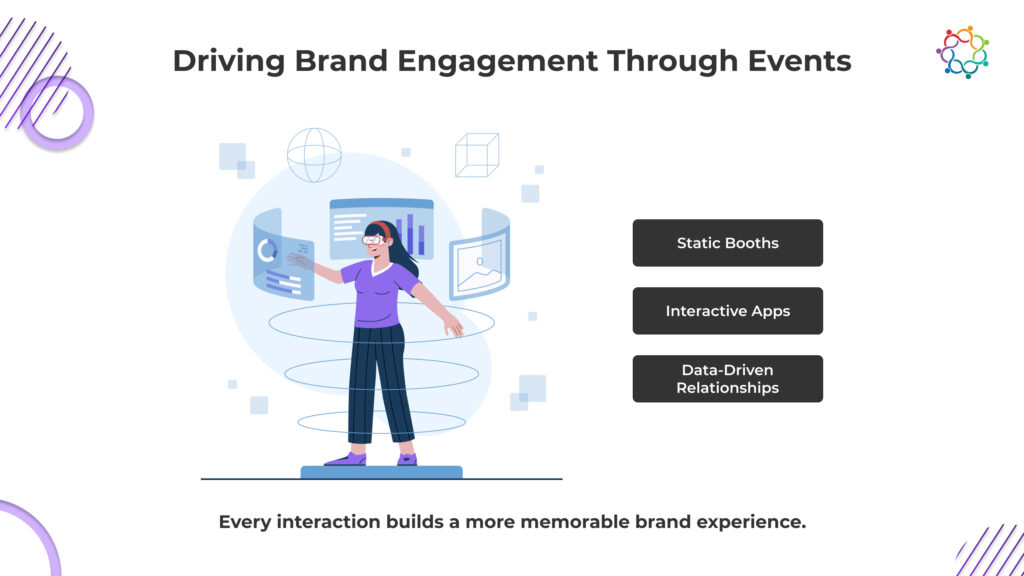
In a competitive landscape of events, they now have to do more than provide an exchange of information but should be considering an experience that creates brand engagement and loyalty.
When selecting the best event management platforms in UAE, enterprises place emphasis on local requirements and enterprise-grade security.
| Feature Category | Priority Requirement for UAE Businesses |
| Logistics & Scale | RSVP automation, custom ticketing, multi-event management. |
| Data & ROI | Real-time analytics, robust CRM sync (e.g., Salesforce), customizable lead scoring. |
| Attendee Experience | Mobile app, multilingual support (English and Arabic), AI-powered matchmaking. |
| Security & Compliance | Strict Data security and compliance with both global standards (like GDPR) and regional laws for data residency and privacy. |
Samaaro empowers UAE businesses to run events that are not just organized, but optimized for growth, compliance, and measurable engagement.
The platform combines the sophistication global brands expect with the localization, compliance, and personalization standards that UAE enterprises demand.
Samaaro’s infrastructure supports data residency compliance and enterprise-grade security, ensuring all attendee and financial data stays within approved regional servers. The platform is built to align with both global standards (GDPR) and UAE data privacy regulations, helping organizations host events confidently and compliantly.
Designed for the UAE’s international business environment, Samaaro offers multilingual attendee interfaces (English & Arabic) and region-specific branding options. From local trade exhibitions in Sharjah to high-level corporate forums in Dubai, your attendees get a tailored experience that feels culturally and linguistically relevant.
Samaaro streamlines the entire event lifecycle, from pre-event promotion, AI-driven registration, and on-site check-in to post-event analytics and follow-ups.
The platform’s real-time dashboards allow organizers to measure attendance, engagement, and lead quality instantly. You can view which session or sponsor booth generated the most conversions, and export ROI reports that tie every registration and meeting directly to pipeline value.
With the UAE’s global audience in mind, Samaaro supports hybrid-ready workflows, combining in-person precision with digital reach. Organizers can manage both local and remote attendees seamlessly through integrated live streaming, session tracking, and digital networking lounges.
From one-off corporate conferences to recurring summits, Samaaro’s platform scales effortlessly across departments, business units, and geographies. Built for large enterprises, it supports multi-event management, role-based permissions, and custom branding per event, helping UAE organizations deliver consistent, high-impact brand experiences across their portfolio.
Those days of manual spreadsheets and silos of data for events are finished. UAE companies are turning their high stakes logistics into significant lead generation and customer loyalty drivers by leveraging event technology to help. With the complete event management software UAE companies can host world-class events with a strong confidence in being on time, the event will look beautiful and lead to transparent and measurable event contributions to the bottom line.
Learn how Samaaro is equipping UAE businesses with event management technology built for growth.
The future of event marketing is prediction, not reaction. By 2026, campaigns will begin long before the registration opens. Using AI models to analyse audience data, prior attendees, and engagement metrics, we will have the ability to predict how the campaign is likely to perform. This predictive intelligence can help marketers decide which channels deserve more spend, the content that drives conversion, and how to balance awareness and retention.
No longer are static campaigns effective. Brands are using adaptive strategies to personalise their outreach in real-time as the behaviour of attendees unfolds. A financial services firm can now predict which attendees are most likely to convert into investors, even before the event begins. Benefits include better engagement and content returns, as well as less wasted impressions.
To truly understand this transformation, it helps to think of events as living, learning systems powered by data. Instead of one-off campaigns, brands now run continuous engagement loops where every click, RSVP, and interaction feeds insights back into the system, creating smarter future events. For a deeper dive into the evolving strategies shaping this shift, explore Samaaro’s comprehensive guide on event marketing trends: Event Marketing 2025: Strategies That Deliver Real Results.
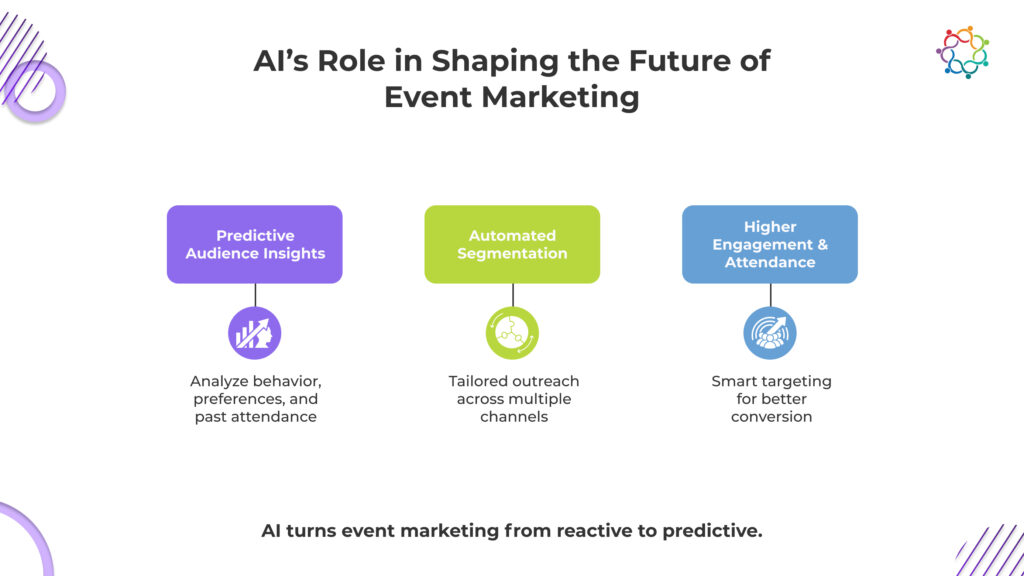
AI has become the intelligence behind every successful campaign. Predictive analytics allows organisers to see who will likely attend or how they will still engage with content and confidently move the audience from interest to action. Automated segmentation refines how you can appropriately target your audiences, ensuring that meeting each communication touchpoint from invitations through to post-event reminders will resonate.
AI chatbots engage attendees at the early stages of the event process by not just qualifying leads but also answering questions in real-time. AI chatbots can also detect sentiment from responses, enabling marketers to see if there is excitement or hesitation so that follow-up can be appropriately tailored. Some organisers have indicated an increase of over 40% registration engagement when adding an AI-driven marketing workflow to their pre-event campaigns.

Audiences do not exist anymore exclusively on a single channel. They may have received the initial invite via email, followed the updates on LinkedIn, RSVP’d on WhatsApp, and participated in the event via a mobile application, all the while playing out an attendee journey. This is the direction for the future of event marketing; an omnichannel personalisation of the attendee journey that feels seamless, relevant and consistent at every touchpoint.
AI enables brands to link all these touchpoints and allow for one continuous attendee journey. A BFSI firm, for instance, can track how an attendee is engaging with its email, ads, and mobile app, and build a picture of its preferences, thereby delivering a fully personalised experience. Rather than fussing with outreach across silos, brands are delivering one experience with consistency across platforms, creating comfort and trust.
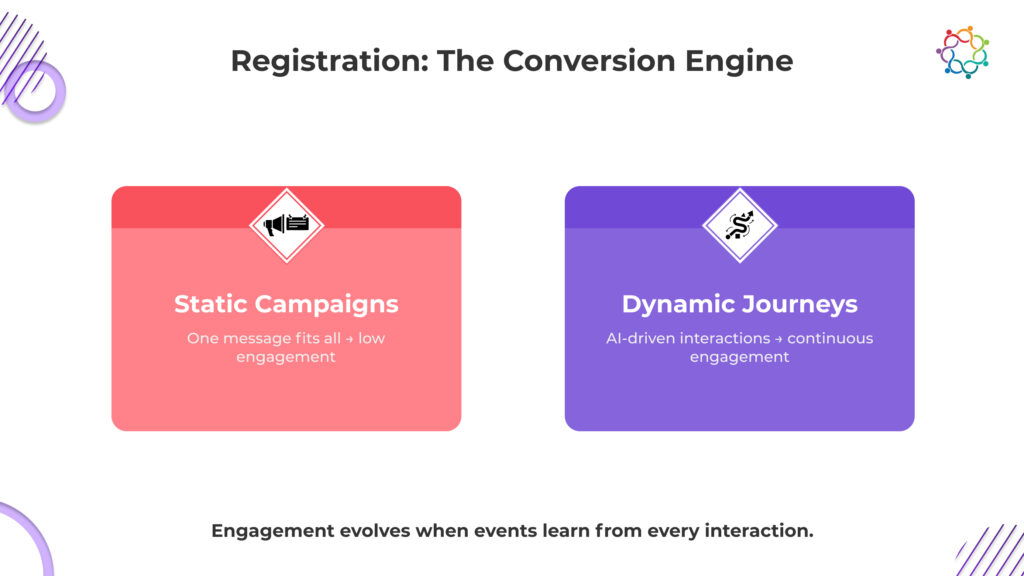
As of 2026, the concept of audience engagement is focused on real-time engagement, not just giveaways or gimmicks. The use of AI to monitor engagement signals delivered during the session and then help modify the event experience is what’s possible. When attention metrics drop, the virtual technology could activate polls, suggest activating a Q&A, or suggest networking ways to boost energy levels.
Also, session attendees could receive intelligent alerts / reminders throughout the event, alerts to sessions that align with their profile and previous interests, alerts when the topic was trending, and alerts to meet the featured speaker. At the event’s close, AI-generated scores would identify which attendees were engaged, allowing teams to easily prioritise follow up and sales conversations that would emerge after the event.
The event technology environment in 2026 is increasingly intelligent, predictive and ROI-focused. Organisers are no longer reliant on only a CRM or analytics dashboard; they are leveraging a new generation of AI-empowered event applications and marketing systems optimized for forecasting, automation and decision support. Some of the catalysts of change in this regard include:
Samaaro is redefining how brands plan, market, and measure events in the age of intelligence.
The platform brings together AI-driven prediction, omnichannel personalization, and revenue-focused analytics, giving event marketers the power to anticipate, engage, and optimize every attendee interaction in real time.
Samaaro’s AI engine analyses past event data, attendee demographics, and engagement behaviour to forecast campaign performance before launch.
Marketers can predict likely attendance, engagement hotspots, and sponsor ROI, transforming planning from guesswork into data-backed certainty.
Promote your event across email, SMS, WhatsApp, and push notifications, all from one platform.
Samaaro’s automation engine ensures every message adapts to audience behaviour: reminding inactive users, rewarding loyal attendees, and re-engaging high-value prospects at the right moment, on the right channel.
During the event, Samaaro tracks live attendee interactions, session participation, app engagement, and booth visits, assigning each attendee an Engagement Score.
This allows event teams and sales reps to prioritize high-intent leads instantly and trigger personalized follow-ups while interest is at its peak.
Each attendee’s journey is dynamically tailored. If someone misses a keynote, Samaaro recommends similar sessions; if they show interest in a specific sponsor, it nudges them toward related offers.
This continuous optimization ensures relevance, reduces drop-offs, and maximizes attendee satisfaction.
Samaaro connects every touchpoint, marketing, registration, attendance, engagement, and sales, into one unified, visual dashboard.
Marketers can see exactly which campaign drove which registrants, which sessions converted them, and how event spend translated into measurable pipeline value.
With native integrations into Salesforce, HubSpot, and other marketing tools, Samaaro ensures every event-generated lead flows directly into your revenue pipeline.
This means events stop being a marketing black box and become a verifiable revenue channel.
By 2026, event marketing will be dominated by marketers most successful at marrying creativity with intelligence: on the one hand, Artificial Intelligence (AI) delivers a degree of foresight; on the other hand, omnichannel personalisation accommodates interacting with consumers at every touch point. When applied together, they create for the marketer an opportunity to get rid of vanity metrics, and begin dealing with the things that really mattered, so marketers can create engagement that is meaningful, and not only measurable engagement, but ideally measurable engagement that affects growth.
If you’re interested in futureproofing your event marketing approach to develop smarter, data-driven experiences, check out Samaaro’s AI-ready event platform today- https://samaaro.com/
The banking, financial services, and insurance (BFSI) industry runs on trust, the currency of the future, and trust comes from exclusivity. In person experiences on a crowded, lively conference floor are being replaced by unique, curated high-touch experiences, specifically built for maximum relevance and privacy.
Closed-door and invite-only formats are now the new gold standard for engaging high-net-worth individuals (HNIs), C-suite executives, and institutional investors. These types of engagements are specifically designed to build deep and meaningful relationships. The framework is straightforward, curated engagements fundamentally alter quality versus quantity with BFSI engagements. The focus is on generating a high-value outcome, and not just high attendance.
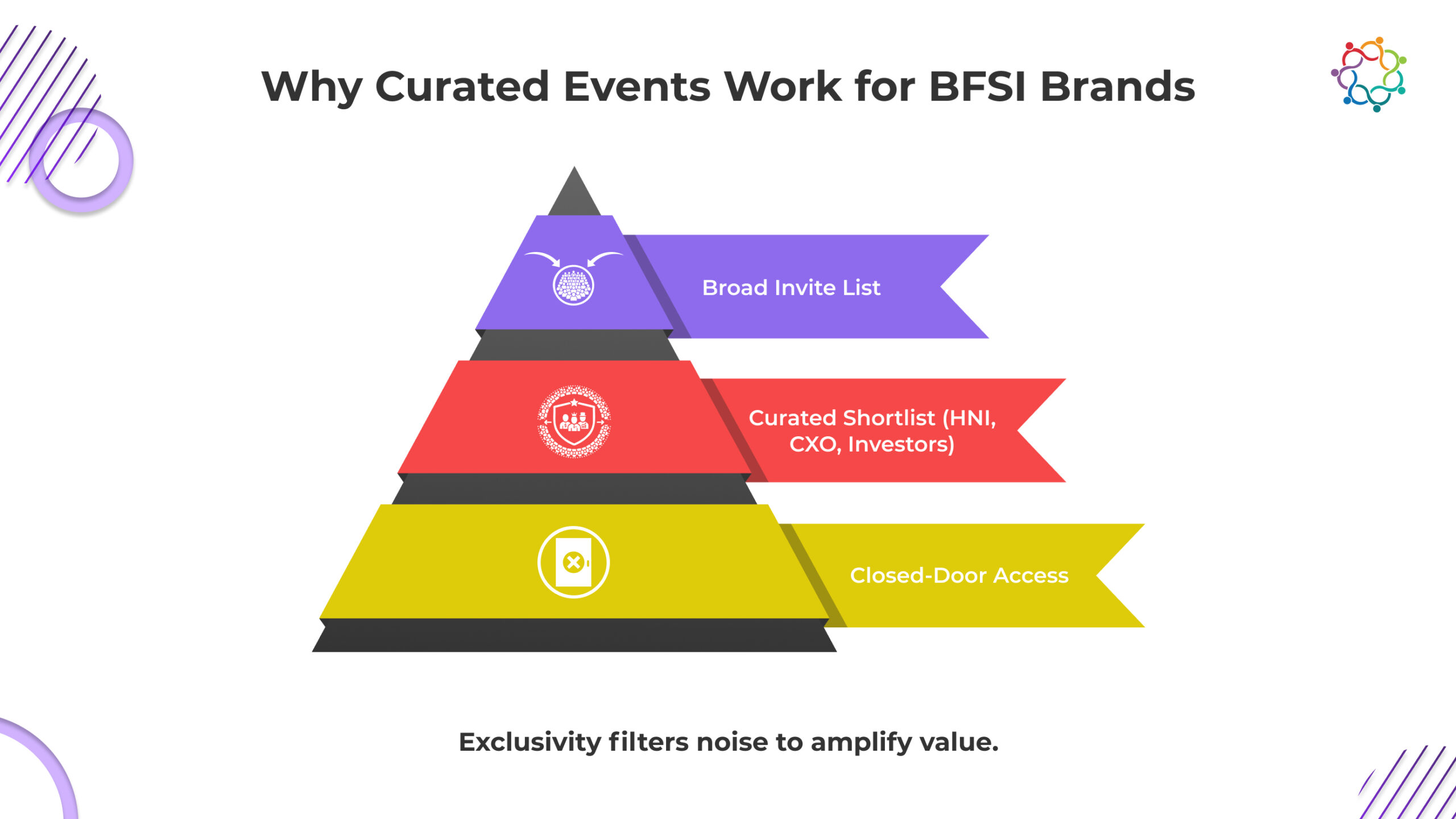
The BFSI audience is unique. They are busy, demand accuracy and need complete privacy. Curated events meet that fundamental need in ways mass forums cannot.
Addressing Relevance and Privacy
HNI, CXO and investor audiences have the preference for relevance and privacy. They could not be less interested in the generic panel discussions and would much prefer proprietary information shared with them privately among peers. Curated events provide for this need and are therefore the preferred format for genuine peer-to-peer networking.
Driving Deep Relationship-Building
By managing attendance to selected guests, personalized session curation facilitates deep relationship-building. New opportunities can arise from a private roundtable on alternative investments or executive dinner that revolves around regulatory changes, but the setting is the catalyst to establish trust and partnership quickly.
Any curated experience has its own direct, measurable relevancy to the bottom line. Think through this: a private wealth summit, quarterly invite only, generated ₹100 crore in follow-up deals sourced from a highly focused, highly trusting network environment.
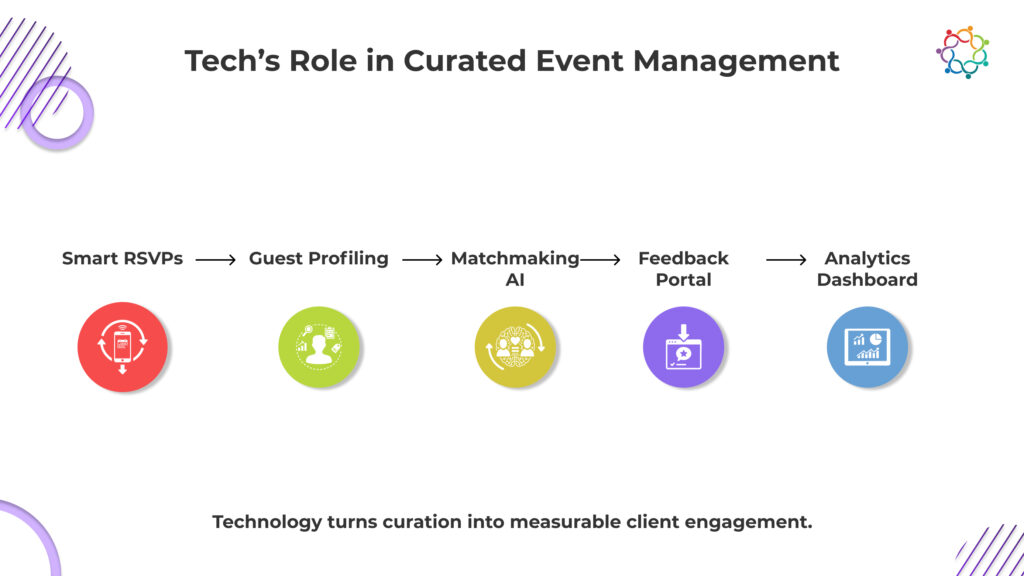
The unique, collaborative nature of your BFSI networking events is made possible by cutting-edge event technology which is designed with privacy and precision at the forefront.
Precision Access Control
It all begins with controlling access. Intelligently crafted RSVP and whitelist systems guarantee that exclusive, invited participants are the only individuals permitted to register and attend which supports the exclusivity and worth of the event from the very first point of contact.
Intelligent Matchmaking
Your events should maximize value from your guest’s attendance, event technology offers a game-changing, AI based guest profiling and matchmaking process. This offers recommendations for 1:1 meeting between investors and fund managers or between CXOs grappling with the same challenge – turning chance encounters to intentional encounters.
Secure Information Delivery
Contrary to how it might appear, there can be a false sense of security surrounding the sensitivities of the content and proprietary content. The agenda and feedback is provided via a secure portal. The proprietary presentations the post-event summary delivered only to the confirmed, exclusive audience. The future of BFSI engagement is personalization at scale, which relies heavily on these secure, tailored event technologies. You can read more about this shift here: https://samaaro.com/bfsi-events/the-future-of-bfsi-events-personalization-at-scale/.

The fundamental aspects of private BFSI events inherently promote a higher level of trust and deeper brand loyalty.
Loyalty through Intimacy
A smaller audience equals more engagement and better client loyalty. They feel valued and appreciated, realizing their time will not be wasted listening to irrelevant sessions. The low attendance indicates that the content and the connection are meaningfully relevant.
Increased Brand Prestige
Creating an authentic private banking and investor event rapidly enhances brand prestige through exclusivity. It elevates the hosting company from mere service provider to a convenor of industry leaders and meaningful conversations.
Data-Driven Intelligence
Most importantly, this high-touch format allows for granular data capture. Every interaction, question asked, and each session attended all become fodder for data-driven insight systems that reveal attendee preferences and intent, enabling unparalleled insight into future client needs and market movement.
Samaaro is dedicated to providing the necessary platform for you to execute secure and successful exclusive BFSI events.
The shift away from large-scale events to high-value, curated gatherings is irreversible. In 2026, exclusive experiences will dominate BFSI engagement strategy, serving as the most effective method for building the trust required to close major deals in the finance sector. To succeed, firms must partner with technology that can deliver both exclusivity and advanced data security.
Want to host curated, data-secure BFSI events? Discover Samaaro’s enterprise event solutions.
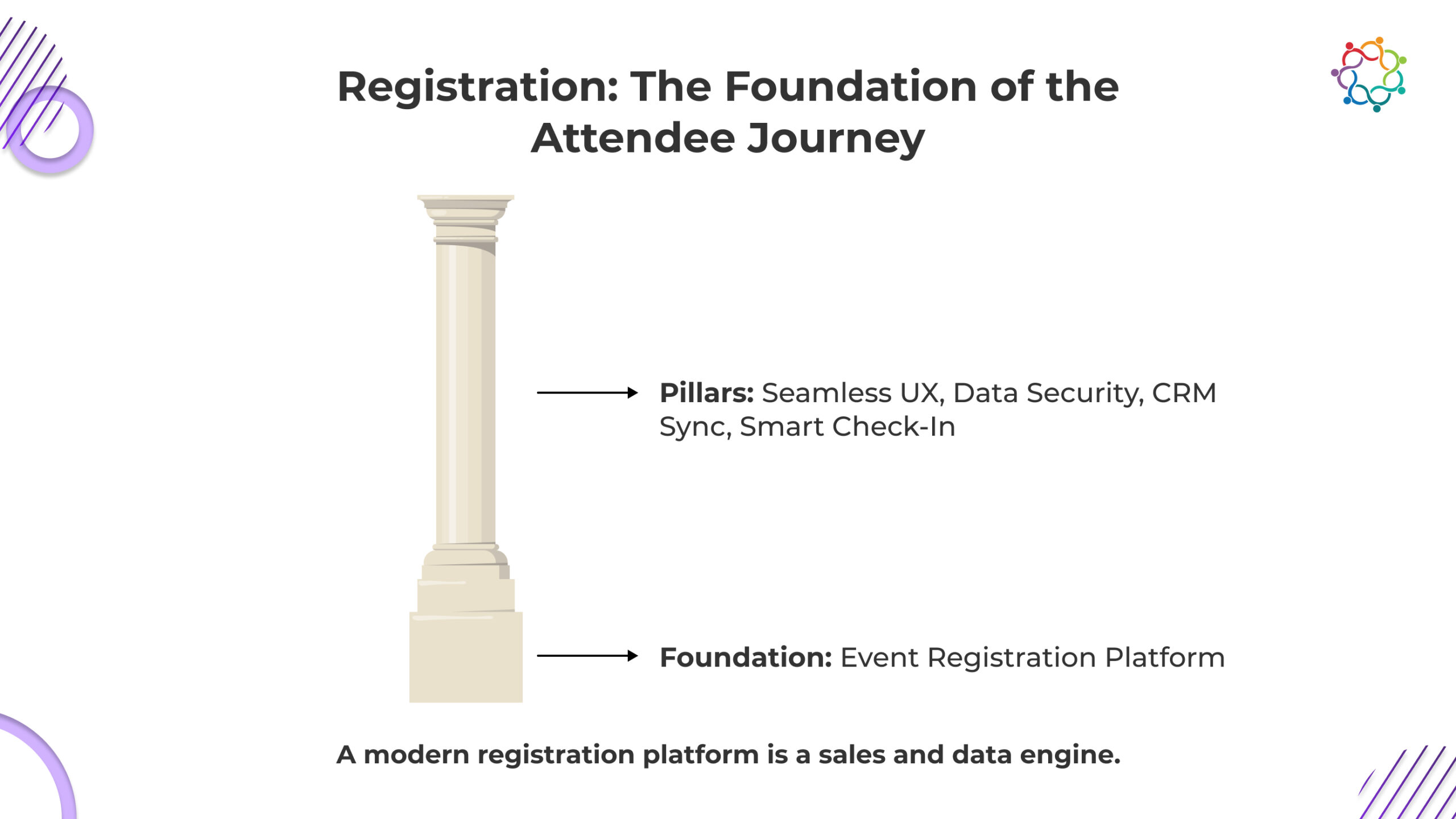
The moment a prospective attendee gets to your registration page, the attendee journey starts. A smooth, professional, and personalized registration experience is the difference between a lead with high intent, or a frustrated dropout. So many brands still see registration as an administrative task; a static, online form feeding into a spreadsheet.
It’s 2026 and that way of thinking is dead. Event registration software has matured into a sophisticated, intelligent, data, and conversion machine using artificial intelligence. It has become the central nervous system for your overall pre-event strategy. If you don’t have all the right features in one place you will jeopardize your data integrity, compliance, and most importantly your events quantifiable ROI. This article explores the ten mandatory features of a truly modern, high-impact event registration experience.
Learn more about how to drive stakeholder success using features like custom ticket tiers and comprehensive reporting in this post on 6 Ways Samaaro’s Event Registration Solution Drives Stakeholder Satisfaction.

The Old Way: Static forms that ask all attendees the same 20 questions (whether they are relevant or not), resulting in form fatigue and abandonment.
The Modern Way: Customizable Registration Forms that utilize conditional logic are crucial. The form adapts to prior responses. If a registrant answers healthcare professional, the form pre-populates fields for their license number or area of expertise. If they answer press, the form asks about media outlet and the focus of their story. The process (often supported by AI in the workflow design process) solves two problems.
Samaaro allows for Ticket-Specific Forms, so you can be sure to collect the right data from VIPs vs. standard attendees.
The Old Way: Manually sorting through the flood of registrants at exclusive or high-value events.
The Modern Way: A modern sophisticated platform acts as a gatekeeper. It immediately segments attendees upon registration in real-time based on job title, company size or ticket type. For private events (e.g., BFSI Investor Meets or closed Pharma sessions), this means Approval-Based Registrations. The system flags applicants who meet predetermined criteria – therefore, the admin has the ability to approve immediately, or add low-fit registrants to a waitlist.
This keeps the registration process regulated and ensures high-quality attendees, ultimately allowing event organizers to guard demographic representation against unqualified leads.
The Old Way: You are required to utilize the platform’s proprietary payment processor, which has double dues (the platform’s commission and the bank’s-perceived fee).
The Modern Way: For any paid event, a truly modern event registration platform that accepts a paid ticket option must offer Zero-Platform Fees on paid tickets by integrating with whichever secure, third-party payment processor you choose (Stripe, PayPal, etc.). This puts the organizer in completely control of their funds, minimizes transactional friction, and maximizes revenue potential (premium ticket sales or tiered ticket sales would be financially viable). This is also crucial when it comes to documenting the profitability of an event.
The Old Way: Chaotic entry lines, paper lists, and pre-printed badges that often go missing or require manual alphabetizing.
The Modern Way: The platform must support seamless conversion from digital ticket to physical entry. Smart Check-In leverages QR codes, NFC, or increasingly, simple tablet-based facial recognition for high-security environments. Attendees scan their digital ticket for instant entry, and the system simultaneously triggers on-demand badge printing. This drastically cuts wait times, eliminates human error, and ensures the data captured at registration is instantly linked to event attendance.
The Old Way: The disconnect where event data is siloed, requiring cumbersome batch-exports and manual uploads days after the event concludes.
The Modern Way: This is the most critical feature for proving ROI. The platform must offer Seamless CRM and Marketing Automation Sync (e.g., Salesforce, HubSpot, Mailchimp). The moment an attendee completes registration, their data is pushed in real-time to the CRM. This ensures sales receives an instant notification for follow-up, and the lead is automatically enrolled in the correct pre-event nurture sequence. Registration becomes a true sales enablement tool.
The Old Approach: Concentrating merely on the registration page, and estimating which channel was responsible for the signup.
The New Approach: The tool will handle RSVPs from all entry points, including the event website, dedicated email links, ads on social networks, and even partner sites. Samaaro provides incredibly advanced Multi-Channel RSVP Tracking with Affiliate Tracking. It lets you generate unique, trackable links (also known as UTM links) for every marketing effort, allowing you to measure which partner, speaker, or social channel generated each registration. In this manner, you will have the fine-grained attribution data needed to determine the value in future marketing expenditures.
The Old Way: Sending the same generic confirmation email to everyone, failing to build value or reduce no-shows.
The Modern Way: Beyond simple Automated Confirmation & Reminders, the platform must support hyper-personalized communication. Based on the data collected in Feature 1 (e.g., job title or session choice), the system automatically triggers tailored pre-event content, like a session-specific reading or a personalized networking tip, to increase excitement and perceived value, leading to a demonstrable reduction in no-shows.
The Old Way: Requiring one corporate buyer to manually fill out 10 identical forms is a significant source of friction for B2B sales.
The Modern Way: Improve B2B and corporate sales by offering Group/Team Registrations and a Bulk Registration portal. This allows a corporate buyer to register 20 employees in one transaction, many times at a discount and with less data entry by the company for each team member. This frees up a logistic barrier to larger enterprise attendance.
The Old Way: Ignoring compliance and relying on basic server security, exposing attendee data.
The Modern Way: This is an absolute necessity, especially in regulated industries like Pharma and BFSI. The platform must be GDPR-ready and offer enterprise-grade data encryption, robust access controls, and transparent data handling protocols. Data security and compliance features are non-negotiable requirements for handling sensitive attendee information and payment details.
The Old Way: Waiting days or weeks for accounting to put together a completed sales report.
The Modern Way: The platform is a live financial tool. You require Real-Time Financial and Attribution Dashboards which show ticket sales in real time, revenue by ticket tier, and ROI data broken out by campaign.
Therefore, marketers can make informed decisions about our data while the campaign is happening, such as engaging a flash sale for a specific ticket type to maximize ticket sales, or the right ad spend by positioning cost against which channel is converting the best in order to get the most out of the campaign in both revenue and efficiency.
When you’re evaluating an event registration platform, you want more than just a form, you want registration to become a lead-engine. Samaaro’s Ticketing & Registration module turns sign-ups into sales-ready data, with features built to support modern event ROI thinking.
Here’s how Samaaro delivers:
By leveraging these features, Samaaro helps organisations move registration away from being an administrative burden, towards being a strategic, conversion-driven entry point into your event ecosystem.
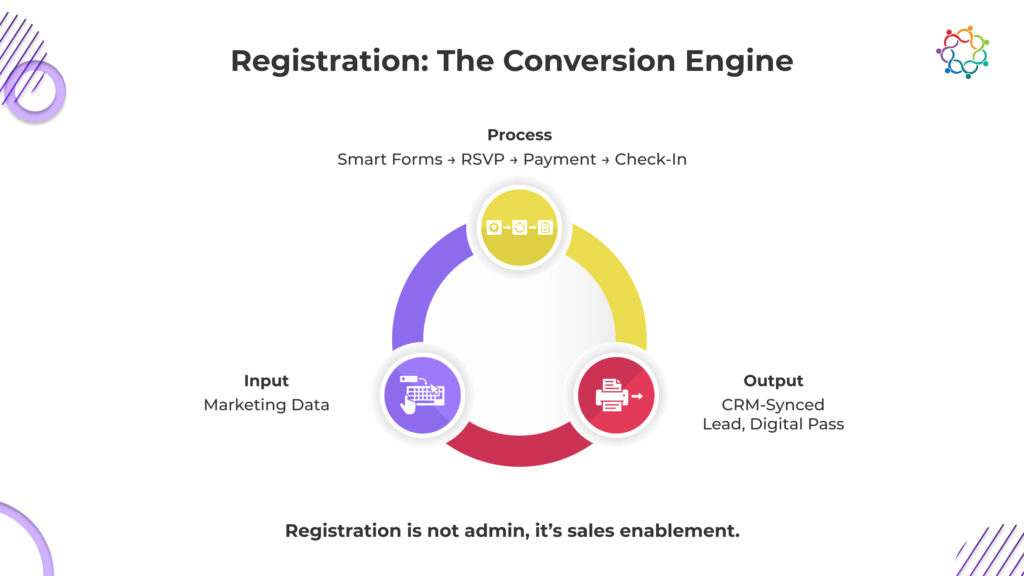
The contemporary event registration platform is a vital first step toward a successful event strategy. With a solution that includes these ten high-impact, cutting-edge features, you can elevate registration from an administrative activity to a dynamic conversion engine that delivers qualified leads, reduces no-shows, protects your data, and promises predictable sales follow-up. Rather than merely managing registrants and sign-ups, monetize them using intelligent technology.
Are you looking for the best event registration platform features? Samaaro’s registration platform has you covered.
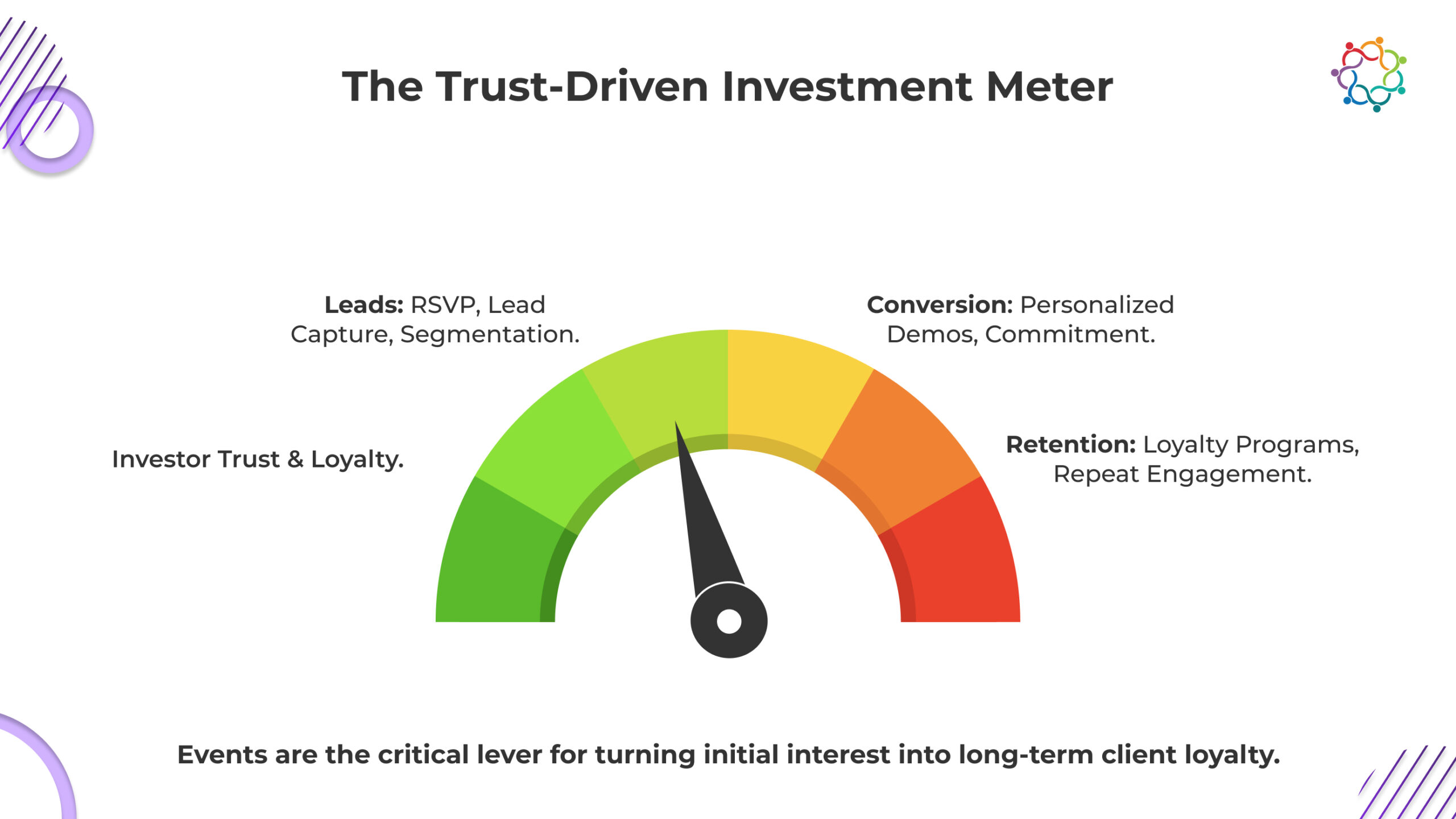
The Financial Services and Insurance (BFSI) industry relies on one, non-negotiable tenet: trust. Retail investors to institutional CXOs will only part with meaningful capital when they have comfort or confidence with your “expertise.”
In this context, events whether they are exclusive investor events, education workshops, or regulatory compliance training, are not marketing expenses; they are one of the critical levers to build and affirm that trust. An event allows a bank or firm to provide its expertise, respond to difficult inquiries directly, and form meaningful individual relationships. The challenge is taking this soft asset (trust) and figuring out how to convert it into hard, measurable event ROI finance.
Financial institutions face a distinct and highly challenging dual challenge regarding hosting events:
A contemporary Event Management Software (EMS) must tackle both issues at the same time, guarantee compliance and provide pipeline visibility.
The pathway from interest (Lead) to ongoing relationship (Loyalty) is where BFSI event technology provides the most value. The event technology platform provides the thread that connects these key stages:
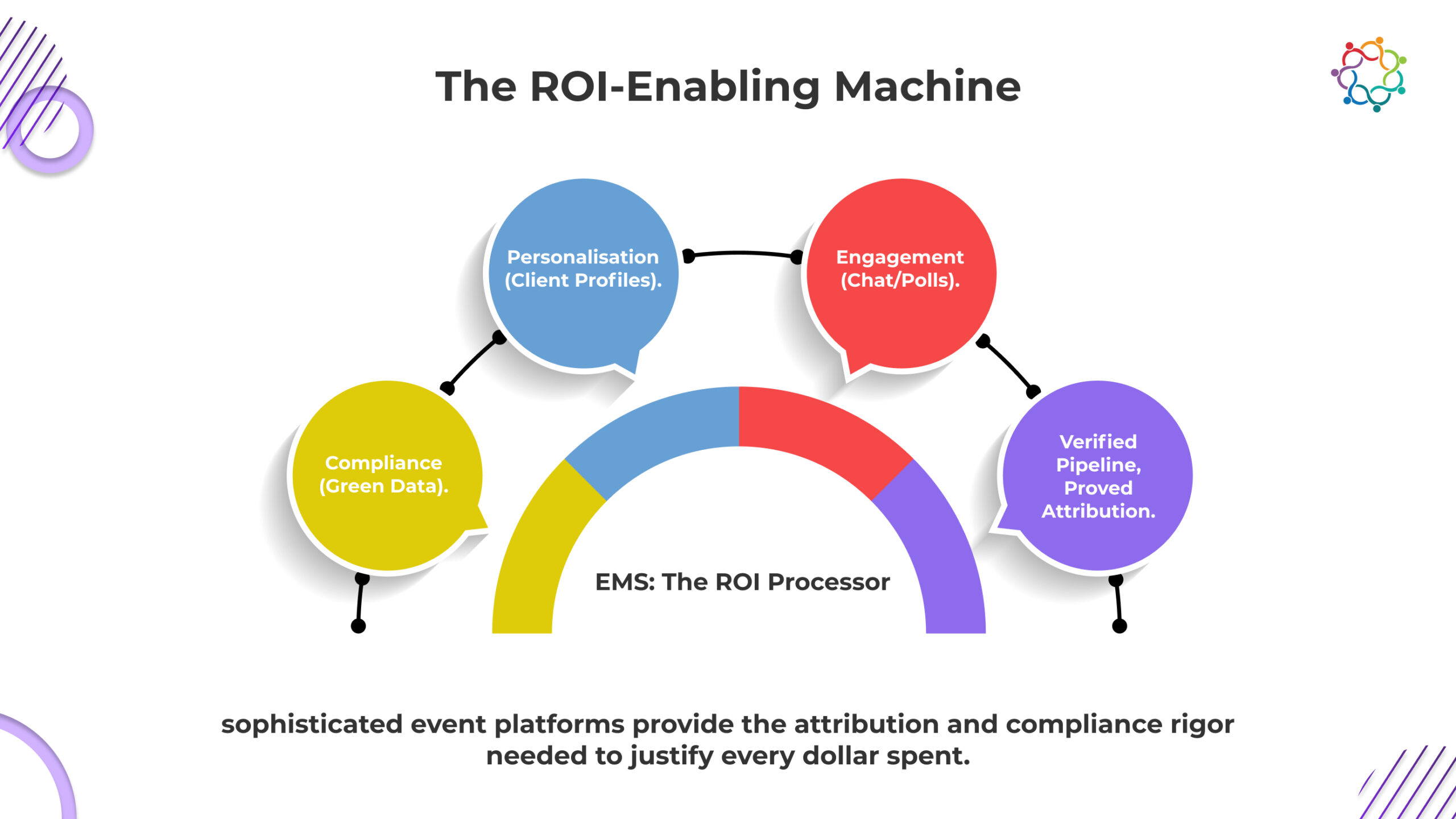
The Event Management Software is the essential solution for converting the BFSI event lifecycle from a trust-based cycle into a measurable investment.

A firm engaged in asset management used a highly effective EMS to host its annual Investor Summit:
In a highly regulated, trust-driven environment like financial services, events are not just nice-to-have, they become critical touchpoints that convert leads into loyal customers. Samaaro addresses this at three levels: Compliance + Personalization + Attribution.
Here’s how Samaaro supports BFSI event strategies:
Within the regulated and competitive financial services landscape, events are essential to develop the trust necessary for every transaction but the days of just running events without justification are over. Decision making on Event Management Software is not merely logistics or safety it is survival.
When Event Management Software provides undeniable compliance, significant personalization, and real time attribution, BFSI event technology can elevate any soft client interaction into hard, attributable/outcome sales revenue.
Want to prove ROI from BFSI events? Check out Samaaro’s financial services offerings.

Field marketing and event marketing have been run as two separates, and at times siloed, departments for long enough.
The premise for 2026 is simple: In 2026, they need to come together as one. Customers do not distinguish whether their interaction with your brand was with the local field team, or the corporate event team; they expect a seamless, unified experience. If both are disparate, there are wasted budgets, unused learnings, disjointed customer and attendee journeys, and fragmented data.
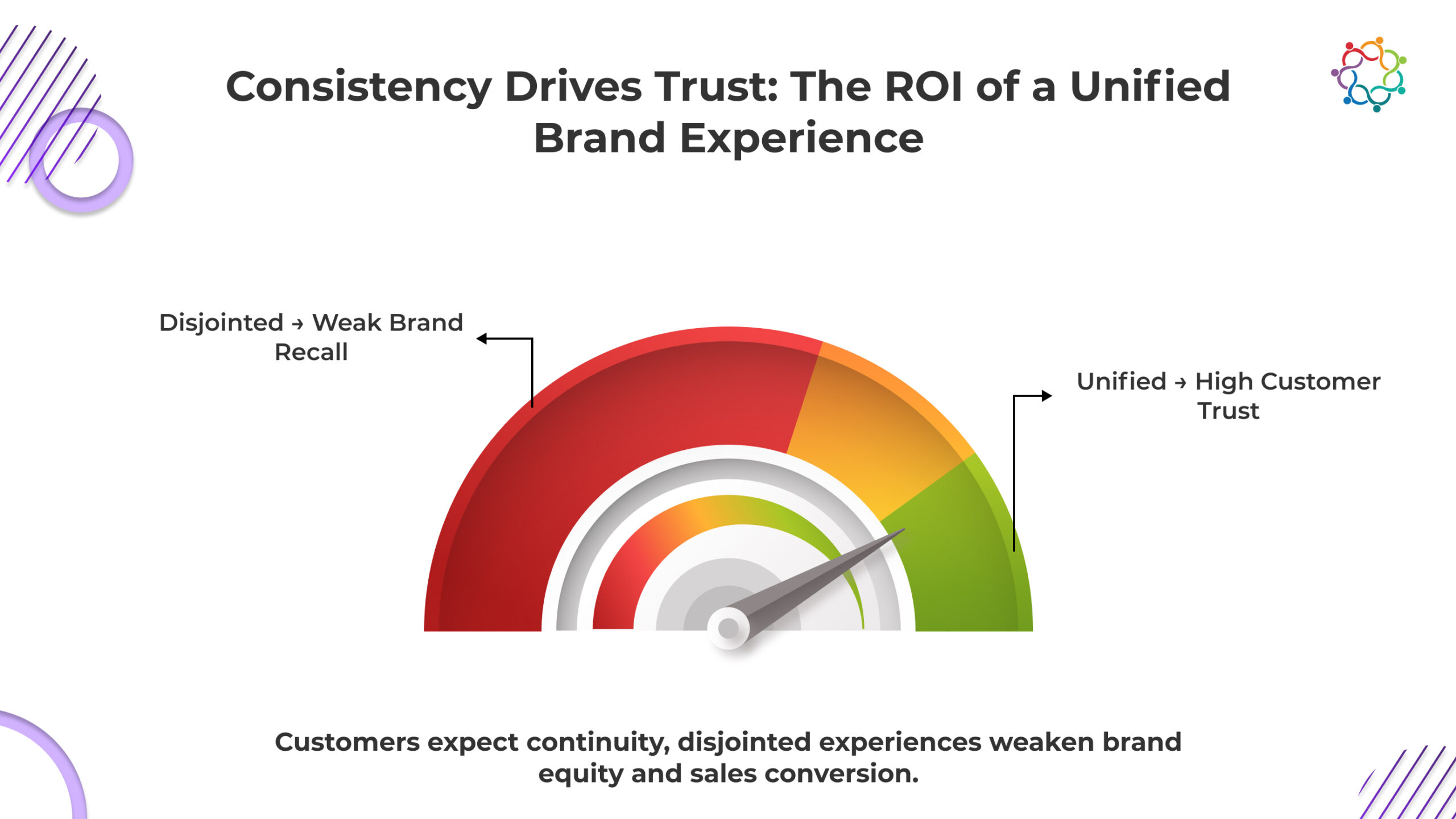
In an era of hyper-personalization, customer consistency has become the new trust currency. If a prospect tries to attend a local field workshop and receives a follow-up email promoting the annual conference requesting the same data they just provided, it instantly disrupts the brand experience. Disjointed experiences reduce brand recall and suggest internal disorganization.
Pathway directed strategy ensures that every touchpoint is tracked, recognized, and utilized to advance the prospect whether it’s a handshake at a local seminar, or a keynote at a global summit. This consistency, uniformity is what leads to higher conversions and lasting customer loyalty. To master this strategy and understand how to drive traceable sales results, consult The Complete Guide to Field Marketing for Impactful Events.
The advantage of fusing field and event marketing is that you develop a sustainable engine for lead generation and lead nurture:
The power of this union turns both functions from cost centres to revenue drivers, with clear attribution and traceability.

Effectively combining these functions can only be accomplished through a unified and robust central technology platform. The event platform must connect customer touchpoints across all levels of engagement.
The crucial technology function is the effortless Data Flow Synergy. The data generated by the field marketing team (i.e., attendance at small local workshops, sign-ups for in-person demos) should flow seamlessly back to the central CRM via the event platform. On a parallel effort, the data generated at the corporate event (i.e., attendance at keynotes, connections made through personalized networking) should flow back to FE teams to inform follow up strategies.
This seamless two-way data highway bridges any offline to online marketing gap and ensures everyone is operating off the same single source of truth.
Consider a large real estate developer launching a new property.
Samaaro empowers marketing teams to operate as one, uniting grassroots field activations and large-scale corporate events under a single data, engagement, and attribution ecosystem.
Here’s how Samaaro bridges the divide:
Whether it’s a small, on-ground activation or a global conference, Samaaro standardizes data collection through mobile lead capture forms, QR-based registrations, and RSVP tracking. Every interaction, from a local demo booth to a corporate keynote, flows back into one centralized system.
From regional WhatsApp invites to large-scale email campaigns, Samaaro’s multi-channel marketing engine ensures both field and event teams can run campaigns from a single dashboard. Each campaign is tracked individually with UTM and affiliate links, making it easy to measure which territory, partner, or medium brought in the most high-quality leads.
Samaaro integrates natively with CRMs like HubSpot and Salesforce, ensuring that all leads — whether captured locally or through event registration, are visible in one unified pipeline. Field teams can view which of their prospects attended central events, while corporate marketing can instantly see which local activities drove conversions.
A core Samaaro differentiator is its real-time attribution analytics. Marketing leaders can track ROI at both micro (local activation) and macro (corporate event) levels, understanding how a single field event influenced the overall buyer journey. This creates transparency in performance and investment justification across teams.
Automated workflows connect every marketing layer. Example: Leads from a field demo automatically receive invites to the next flagship conference, while attendees from the central event are auto-segmented for local sales follow-up. No manual syncing, no data loss, just a continuous, intelligent nurture loop.
For distributed teams, Samaaro offers enterprise-grade security and role-based permissions, ensuring local marketers, regional heads, and corporate teams can collaborate seamlessly while maintaining data integrity across levels.
With Samaaro, brands no longer need to choose between local relevance and centralized scale. The platform transforms Field + Event Marketing into a single growth engine, where data, communication, and relationships move freely between teams, creating a unified, high-trust customer experience from the first handshake to the final sale.
Unified Experiences Win Trust
In 2026, the strength of your brand rests on your ability to unite your marketing and communications efforts. The boundaries that exist between your field marketing and event marketing teams need to be broken down and replaced with a cohesive digital structure that unites your team. When field marketing and event marketing teams work in conjunction – all using the same event platform – the customer feels recognized, valued, and appreciated, resulting in a dramatic increase in trust, customer retention, and ultimately, income.
Do you wish to connect your field and event teams for a seamless brand experience? Check out Samaaro’s platform.

Marketers today face a universal challenge: saturation. The inbox of your audience is filled, their social media feed is a mash-up of advertising, and they either outright ignore, or perceive as mere filler, your standard event promotions (the standard email invite or banner ad).
If your event is to successfully happen in 2026, it can no longer be marketed via standard channels and lone tactics, but requires creative campaigns that compel the audience to act differently by cutting through the noise, creating real excitement, and really thinking of this event as a destination, not just a date on a calendar. Creativity is not just the icing on the cake; it is the engine that generates high intent registrations.
In this article are four examples of real-life event marketing campaigns that are proven to work in a variety of industries, even with strict compliance globally.
To explore these high-impact methods and learn how to transform events into powerful, high-conversion pipelines, read the full guide on Event Marketing 2025: Strategies That Deliver Real Results.

Real Estate has a big challenge to get potential buyers to uphold an expression of interest to attend a property launch. The campaign had to raise anticipation about the launch, as well as convey a sense of exclusivity, even before the event was open for buying.
The Campaign: Instead of simply sending out the typical launch invites, a major developer supplied potential buyers with short, attention-grabbing video teasers in 3D that showcased various areas of the property. The developer used engaging video teasers to replace email sign-ups and interest forms.
The sequences would also appear to be an exclusive series that could be time sensitive; were password protected and could only be viewed a fraction of the final property.
The Result: This campaign generated successful early EOIs or Expressions of Interest, from high value buyers who felt they were already part of an exclusive buyer group, which drastically shortened the sales cycle as attendees arrived pre-sold on the property.
In the highly regulated pharmaceutical and medical education space, the objective isn’t simply attendance; but instead, deep, verifiable engagement for Continuing Medical Education (CME) points.
The Campaign: Prior to a large-scale medical education conference, the sponsoring organization launched a Microlearning Drip campaign – consisting of educational “nudges” prior to the event, with engagement burgeoning throughout. This included short daily quizzes, one-minute videos, and single-slide summaries that were anchored to the course topics. Participation was linked to early certification points.
The Result: The engagement of this seemingly simple campaign ensured that participants entered the conference with a foundational comprehension of the core topics. Increased engagement improved participation rates in the live sessions, but more importantly increased rates of CME completions because the participants were mentally ready and engaged from day one.
Events held by Financial Services (BFSI), particularly those aimed at high net worth or institutional investors, are often built on trust and a perception of exclusivity.
The Campaign: A firm engaged in asset management organized a campaign centered on VIP-Only Investor Previews. Two weeks prior to the event’s flagship summit, the top 20% of the firm’s prospect list received an invitation for a 30-minute preview from one of the firm’s partners. The preview was an exclusive opportunity to see some of the full agenda prior to the summit, as well as to have a curated one-on-one networking session, online, with a senior executive.
The Result: The combination of feeling (or being invited) to an event that was exclusive, and the promise of personal engagement and interaction with a senior executive, significantly built excitement and RSVPs in the target audience of high-value attendees. The invite to this exclusive event provided validation to their importance and value and increased both the quantity and quality of attendees.
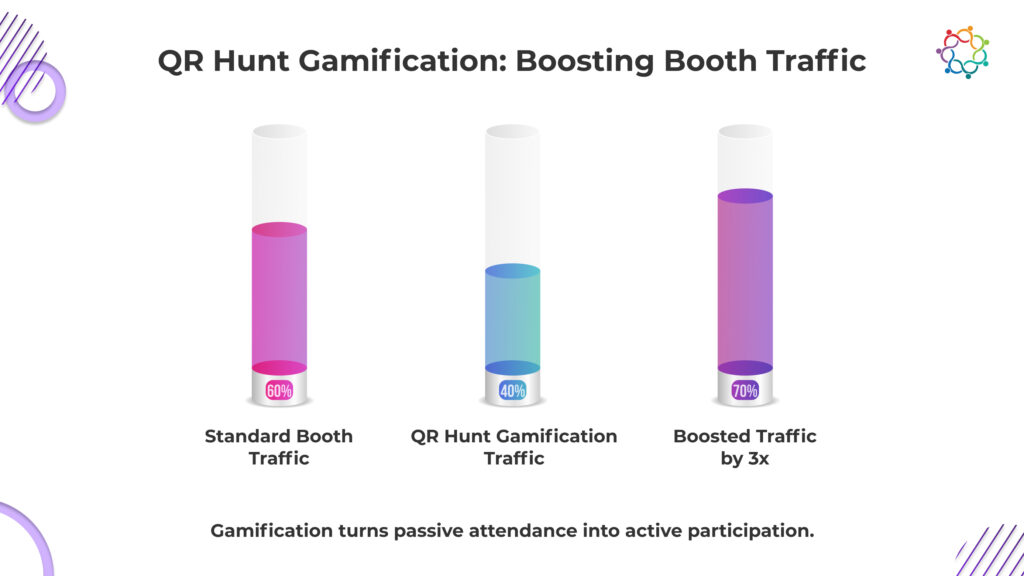
While technology events are all about interaction and product demonstration, attendees often feel inundated and skip visiting booths.
The Campaign: A major tech summit rolled out a platform-based QR Hunt Gamification program. Rather than a traditional scavenger hunt, attendees had to visit certain demo stations and use the event app to scan a .97 QR code. Scanning the QR code exposed new content (deep-dive case study or a discount code) and recorded attendance at that demo.
The Result: With just a simple engaged gamification mechanic for attendees, their booth traffic increased 3x. The process engaged attendees with product teams to turn attendees from passive and distracted visitors to active attendees and could produce verifiable, high intent leads for sales follow-up.
While the industries and tactics differ, these successful campaigns share two universal principles of creative event marketing:
The best event marketing ideas rely on technology that can support sophisticated, multi-touch campaigns. Samaaro provides the tools to execute and measure these creative efforts:
The purpose of reviewing the best event marketing campaigns 2026 has to offer is not to copy them exactly, but to adapt creatively. Take the core mechanics like exclusivity, anticipation, micro-engagement and contextualize them for your audience and brand goals. In the crowded marketing landscape of 2026, the success of your next event will depend on your willingness to be more innovative, personalized, and engaging than your competitors.
Want to design creative campaigns in 2026? Explore Samaaro’s campaign management tools.
Each brand faces a budgeting question worth battling: Where should we allocate our marketing dollars to maximize our return? The decision is often between putting spending behind traditional campaigns (mass, digital ads) that have been historically used or investing in event marketing.
It’s a cyclical argument, with one delivering breadth of reach, while the other delivers depth of engagement. Generally, these informal arguments suggest that traditional ads are less expensive, while events are more expensive, but generate greater engagement.
In this blog, we’ll investigate the true value proposition of event marketing vs traditional marketing, clearly rationalizing how forward-thinking brands should structure these considerations to optimize verifiable trust, and measurable ROI.
For a deeper understanding of how event marketing strategies are evolving with data and technology, explore “Event Marketing 2025: Strategies That Deliver Real Results”. It offers actionable insights on aligning events with measurable business outcomes and audience engagement goals.
Traditional marketing refers to anything that is designed to reach a mass audience, whether through traditional television and print or programmatic display ads in digital form.
Strengths: The chief strength of traditional marketing lies in its Reach. Traditional channels, specifically mass media and targeted digital ad networks, enable brands to plan a message with the potential to reach millions of consumers immediately. Thus, it is well suited for broad brand awareness and product launches.
Weakness: Despite the mass reach, traditional marketing channels will, no doubt, struggle with two significant factors in 2026 – limited consumer trust and excessive ad fatigue. Consumers are inundated with vague, traditional advertising, and their trust has plummeted.
The consumer may see your banner ad or sponsored post in their feed, but seeing a paid advertisement or brand talking about their own business is rarely enough of an emotional connection or relationship to build the trust needed for a higher-value consumer conversion.

Event marketing is on the rise because it offers the exact antidotes to the shortcomings of traditional marketing, trust, context, and immediate feedback.
Example: A major BFSI (Banking, Financial Services and Insurance) brand indicated that while digital advertising generated a high quantity of leads, their quarterly investor meets using proprietary content and one-to-one getting provider sessions, were responsible for driving much higher-value commitments and long term client loyalty.

The most critical difference lies in what each channel measures and how that translates into verifiable ROI.
| Metric Type | Traditional Marketing | Event Marketing |
| Output Focus | Impressions, Clicks, Brand Recall | Measurable Leads, EOIs, Deals |
| Data Quality | Surface-level (anonymous clicks) | Deep-level (role, intent, session attendance) |
| Pipeline Impact | Primarily Top-of-Funnel (Awareness) | Mid-to-Bottom-of-Funnel (Conversion & Sales) |
| Trust Factor | Low | High |
Traditional marketing primarily generates awareness, metrics that are far removed from revenue. Events, however, generate traceable actions like Expressions of Interest (EOIs), demo requests, and signed deals. You can draw a direct line from an attendee’s registration and session attendance to their progression through the sales pipeline, making the ROI of event marketing significantly more transparent and defensible.

The most astute marketing investments for 2026 will not be made in one channel or another, but in the hybrid synergy of both.
Brands must realize that employing events vs. a digital campaign will not be competitors; they will be complements. Traditional digital channels are still vital for top of funnel broad based awareness, general interest in your brand and registrations in your event funnel.
Next, the event serves as your high-trust high conversion mechanism to convert those leads (exhibitors, attendees, partners, sponsors) into pipeline, and then post event, digital follow up creates retention.
In the future we all will have to strategically and budgetarily pull away from broad underperforming awareness ads to budget more into the technology that enables event data to be traceable to action.
To support the case for shifting budget towards events, Samaaro provides a robust marketing ecosystem that transforms event spend into measurable, revenue-oriented outcomes:
By harnessing these capabilities, Samaaro helps brands go beyond “just doing an event” to treating each event as a growth asset, with measurable touchpoints, conversions, and pipeline impact.
The marketing issue is not resolved by selecting one channel or the other, but rather by assigning them the correct role. Traditional marketing casts a wedge, but in 2026, event marketing is the trusted engine of growth that catches the most valuable, high-intent leads. Savvy brands know that trust is the currency of conversion.
Want to get the capabilities to maximize ROI from events? Check out Samaaro’s marketing attribution tools.
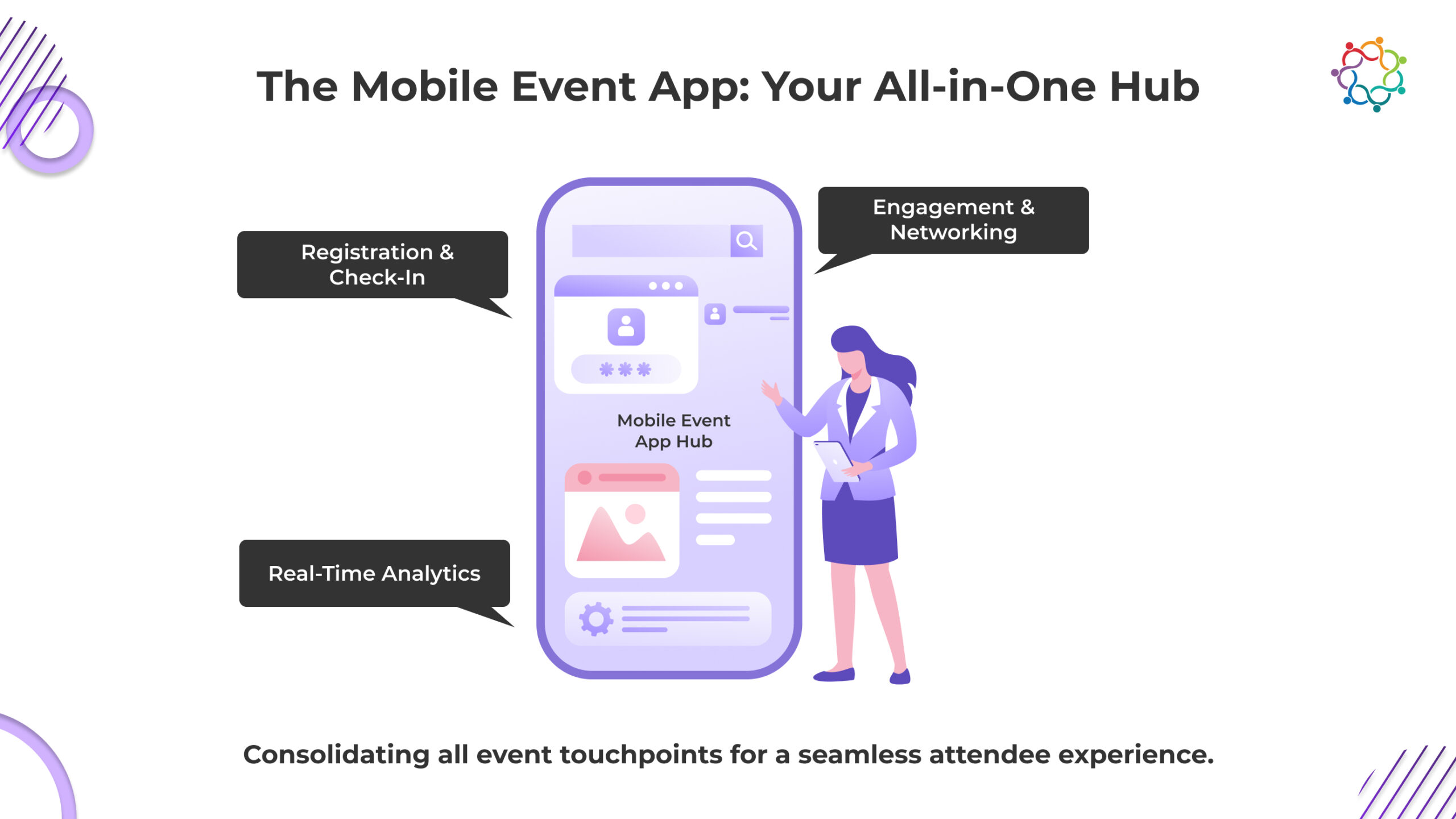
The 2026 event landscape is characterized by convenience, personalization, and interaction. Attendees now refuse to have a fragmented experience across multiple tools or touchpoints. Rather, they expect to visit a single, cohesive platform that includes registration, engagement, and responses.
This evolution has provided mobile event apps the opportunity to sit at the centre of event management. From the moment a visitor registers to post-event feedback and reporting, event apps lead the full experience, enabling the event organizer to control all touchpoints, while providing attendees with an intuitive, enriching experience.
In short, event apps are not a nice-to-have on the event tech stack; they are the operating system for live experiences.
One of the most significant changes made possible through mobile event apps is registration and check-in. Gone are the days of long lines, paper badges, and someone physically checking you in or stamping your registration.
In 2026, apps will scan QR codes, use NFC tags, and likely biometrics to eliminate all friction from the entry process. Users will receive a mobile pass that is unique to their profile, allowing them to be automatically checked in for their sessions and easily record their attendance.
For an event such as a large real estate expo or industry conference in pharmaceuticals with the potential for hundreds of people attending, the system will be seamless, moving people through the entry process and allocating them through the various sessions, with the added benefit of additional security.
For event organizers, this reliability means fewer manual errors, smoother entry operations, and improved overall efficiency. It allows staff to shift their focus from managing processes to engaging in higher-value interactions with attendees, enhancing both operational flow and the overall event experience.
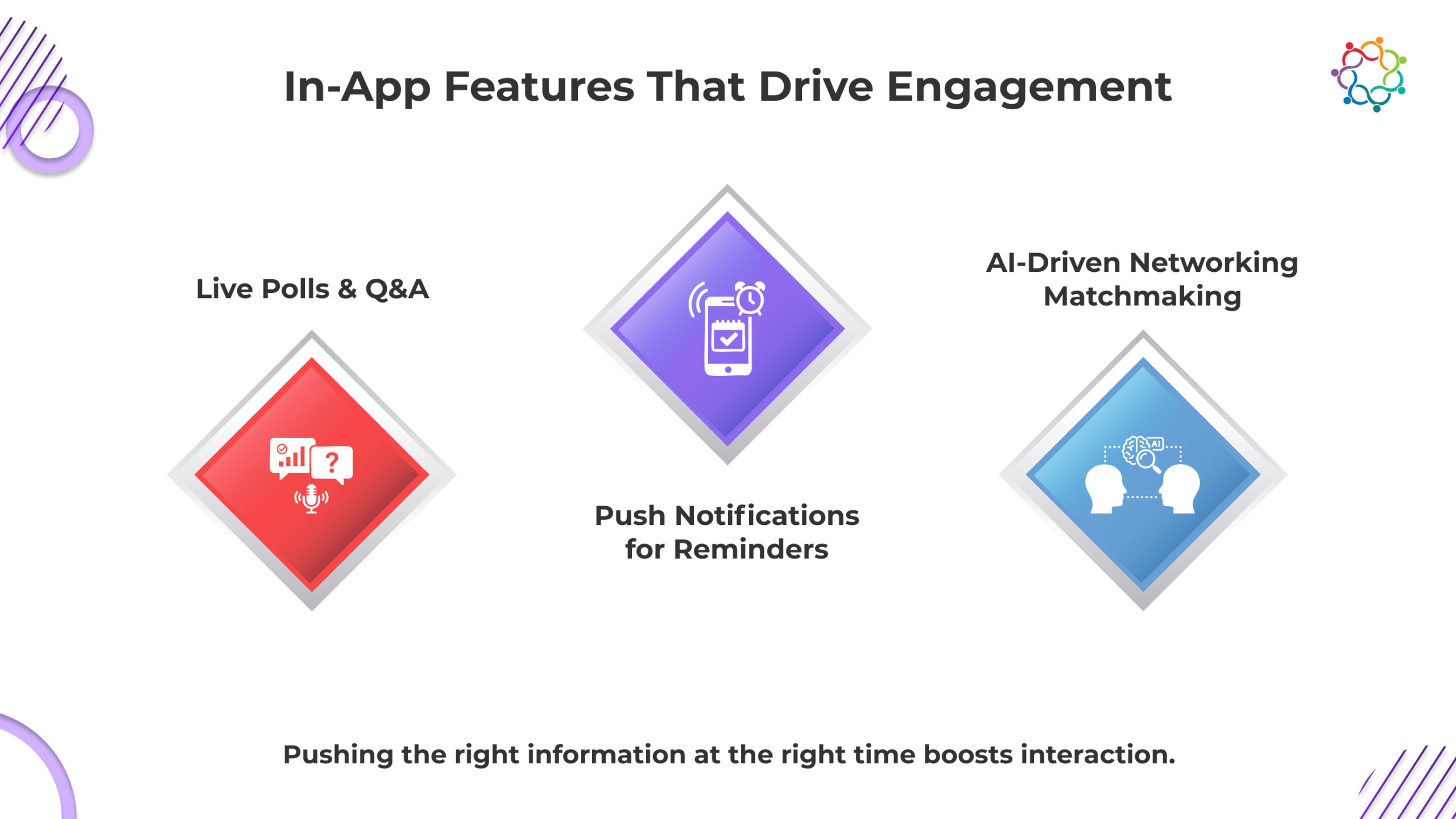
After going through the check-in and registration process and showing proof of vaccination (if required), the second phase of delivering a successful event begins. Once the attendee has their event app downloaded, the next frontier of engagement begins, and event apps bridge the audience to the content.
In 2026, mobile event apps are fully interactive ecosystems. They feature live polls, Q&As, networking lounges, and gamified engagement tools to keep participants active and engaged all day. Organizers use push notifications to navigate attendee flow to certain nearby sessions, announce a last-minute sponsor, or keep traffic to sponsor booths.
Networking is also being reimagined. App-based AI is now suggesting relevant connections, based on attendee profiles, previous participation at a session, and shared interests, allowing professionals in BFSI, real estate, and healthcare industries a base to connect in a more substantial way.
Every tap, chat, and poll submission becomes quantifiable, giving proof and live pulse to external engagement health that organizers can reference during the event.
Mobile apps for event planners aren’t just a way to engage clients; they are a treasure trove of data.
Every registration, session check-in, and completions of polls are recorded into a real time analytics dashboard that informs planners who is engaging during the event. They can see which sessions are most popular based on attendance, the busiest times of day for footfall, and which engagement activities have the highest number of participants.
For example, a developer hosting a launch for a luxury property, will see which projects gain the most interest, allowing them to deploy their sales agents accordingly. A pharma organizer can see real time attendance for CME sessions, as well as compliance credits.
By combining the attendee experience data with CRM systems, planners can better leverage this data for post-event follow-up activities and long-term engagement.
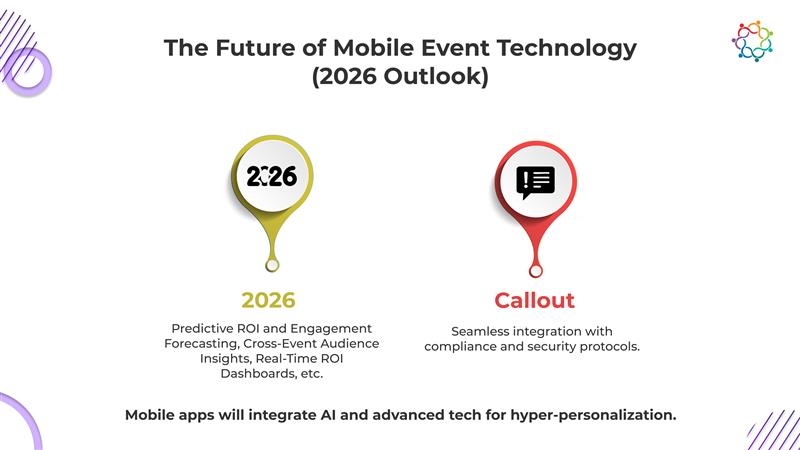
The next wave of mobile event apps is designed for performance, not flash. By 2026, organizers are demanding platforms that directly impact ROI, streamline every touchpoint, and provide predictive intelligence before, during, and after the event.
Here’s what that evolution looks like:
To see how this transformation is already unfolding, explore Samaaro’s analysis of how event technology is driving the next phase of digital transformation in events.
At Samaaro, mobile-first innovation is at the heart of how modern events are built. The Samaaro Mobile Event App serves as a comprehensive event hub, designed to bring together registration, engagement, and analytics under one roof.
Key capabilities include:
Whether it’s a high-stakes BFSI summit, a medical CME conference, or a real estate property expo, Samaaro ensures that event experiences remain fluid, compliant, and data-driven.
As we enter 2026, if an event organizer seeks to deliver measurable, scalable and memorable experiences, mobile event apps are no longer optional. They not only simplify logistics but also reimagine how events work. With effortless registration, intelligent engagement, and real-time analytics, they turn events into continuous journeys of interaction and insight.
It’s time for event teams to ask themselves: Is your event app moving your strategy forward, or is it simply digitizing what already exists?
For organizers looking to bring all these innovations together into a single, intuitive platform, solutions like Samaaro’s Event App Suite are setting new benchmarks in 2026. Explore Samaaro today!

Built for modern marketing teams, Samaaro’s AI-powered event-tech platform helps you run events more efficiently, reduce manual work, engage attendees, capture qualified leads and gain real-time visibility into your events’ performance.
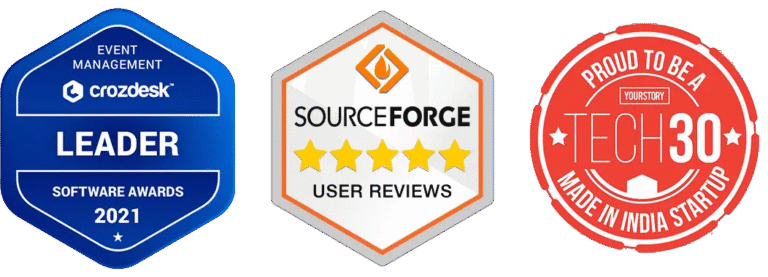

© 2025 — Samaaro. All Rights Reserved.